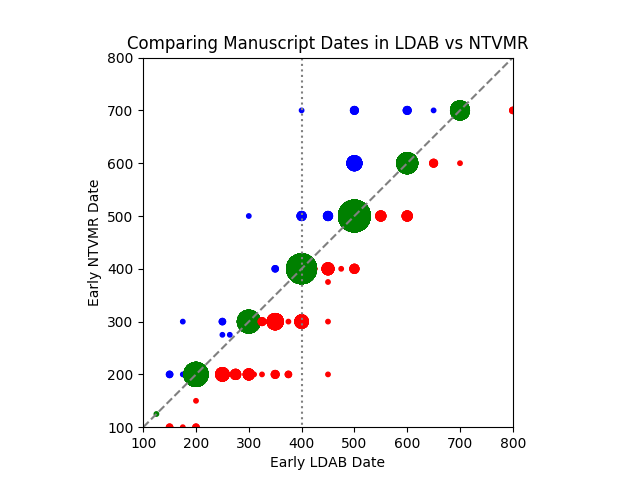|
Getting your Trinity Audio player ready...
|
As I’ve recently updated the table of earliest New Testaments manuscripts, according to dates assigned by Leuven Database of Ancient Books (LDAB) and New Testament Virtual Manuscript Room (NTVMR), I thought it would be interesting to see how these two data sources compare with one another.
Both LDAB and NTVMR hold detailed information on thousands of manuscripts, but only about three hundred are in common between them, that is, entries in one data source are mapped to their counterparts in the other. Therefore my comparison of dates is limited to the latter.
First, both LDAB and NTVMR assign a date range to each manuscript. I choose a simplified and grouped box plot to display these date ranges. Each pair of red and blue vertical bars represents date ranges assigned to a manuscript by LDAB and NTVMR respectively.
The plot shows general agreement between LDAB and NTVMR. It’s not easy to detect other patterns, besides that NTVMR seems to adopt a 100-year range more consistently, whereas LDAB sometimes adopts varied-length date range.
If we compare the earliest dates of these date ranges, however, another interesting pattern emerges:
For those not familiar with scatter plot, a brief explanation: If the two data sources agree perfectly with one another, all the data points would fall on the diagonal line (in green). The data points above the diagonal line (in blue) represent manuscripts to which NTVMR assigned a later date than LDAB, and those below the diagonal line (in red) manuscripts to which NTVMR assigned an earlier date than LDAB. Distance between the data point and the diagonal line indicates differences between NTVMR and LDAB dates -the further the distance, the larger the difference. The size of the data point reflects the number of manuscripts.

For the majority (60%) of the three hundred New Testament manuscripts, the dates from LDAB and NTVMR agree. When they disagree, LDAB more frequently assign later dates than NTVMR, up till the 4th century (shown as red dots in the lower lefthand quadrant); whereas after the 4th century, the trend is somewhat reversed, NTVMR more frequently assign later dates than LDAB (shown as blue dots in the upper righthand quadrant).
Update:
Prof. Clarysse, founder of LDAB, wrote an email in response to my post. With his permission, I’m posting it below for the education of our readers.
This is an interesting graph indeed and I wonder if it does not show some kind of “favouritism” on both sides. My dates, when diverging from those in Münster (but I never compared them) are due to Pasquale Orsini, an Italian paleographer (and palaeography is indeed practiced a lot in Italy) and a reaction against what we called “theological papyrologists”. There was a growing tendency among theologians to date NT papyri earlier and earlier, without good arguments (an extreme case was Thiede in Germany). I did not want to take their dates over in the LDAB because they were not well argued and intrinsically unlikely. So I asked Orsini to have a look at the paleography (because all these dates are based on the script). As a result our reaction may well have tipped towards a later date (though Orsini would certainly not agree!). On the whole our dates are not so different from those of Münster of course, but they may – as theologians – have a preference for earlier dates. The main representatives of this tendency are Comfort-Barrett and Jaros and in our article we also made a kind of graph (not so nice as yours). Apparently there is a new edition of Comfort-Barrett in 2019 and I would very much like to see if they have taken account of our criticism. But our library does not want to buy the new edition, they say they already have the book.
Related Posts:
